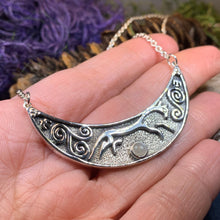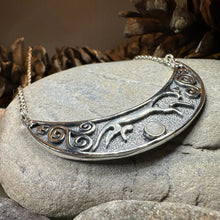
Description
Solid Sterling Silver with rainbow moonstone
The Chalk Horse of Uffington, carved into the side of a hill in England, is believed to be an example of a neolithic representation of the sacred horse.
Depending on the region, the Celtic Goddess of horses was called either Rhiannon or Epona, a Goddess of magic, prosperity, and the realm of the fae. The horse was very important to the Celtic culture allowing for advances in travel, warfare and agriculture. The perfect gift for any lover of Celtic culture and horses!
This beautiful sterling silver pendant comes on an adjustable 16"- 18" sterling silver chain with lobster claw clasp.
Focal frontpiece measures 2 1/8" long by 1/2 inch high in solid sterling silver.
********Epona - Goddess of Horses in Celtic Mythology
Epona, meaning "Divine Mare", was the goddess of horses, including those who worked with them, as well as fertility during the Iron age. Her worship originated with nomadic Celts. Epona was the only Celtic deity venerated in Rome itself.
Epona was the beautiful child of a horse and human male. The importance of horses in Celtic culture may have contributed to her cult spreading from Gaul to Germany and eventually to Rome. Celtic nobles were usually buried with their horses and saddles indicating horses were important in the after-life. The extensive worship of Epona may also be the reason why the Celts did not eat horse meat.
The connection between Epona and horses was also present in the rites of Celtic kings as the goddess was thought to bestow on the king his authority to rule. Epona's importance was later signified with a shrine in nearly every stable because she protected not only the horses but also those who worked with them.






















